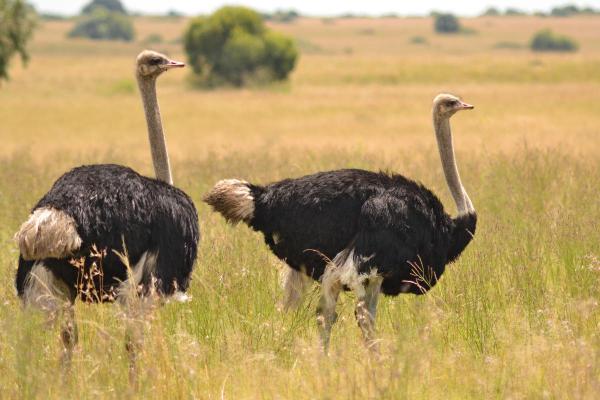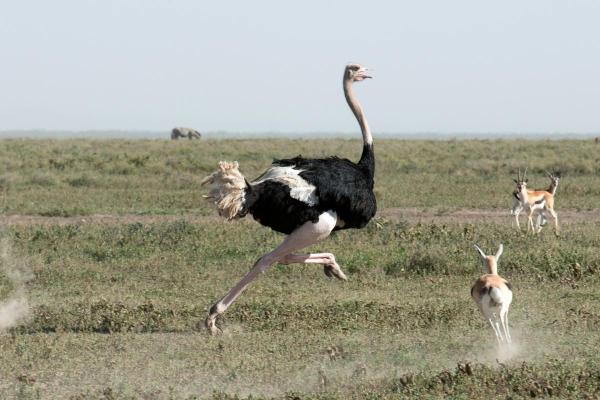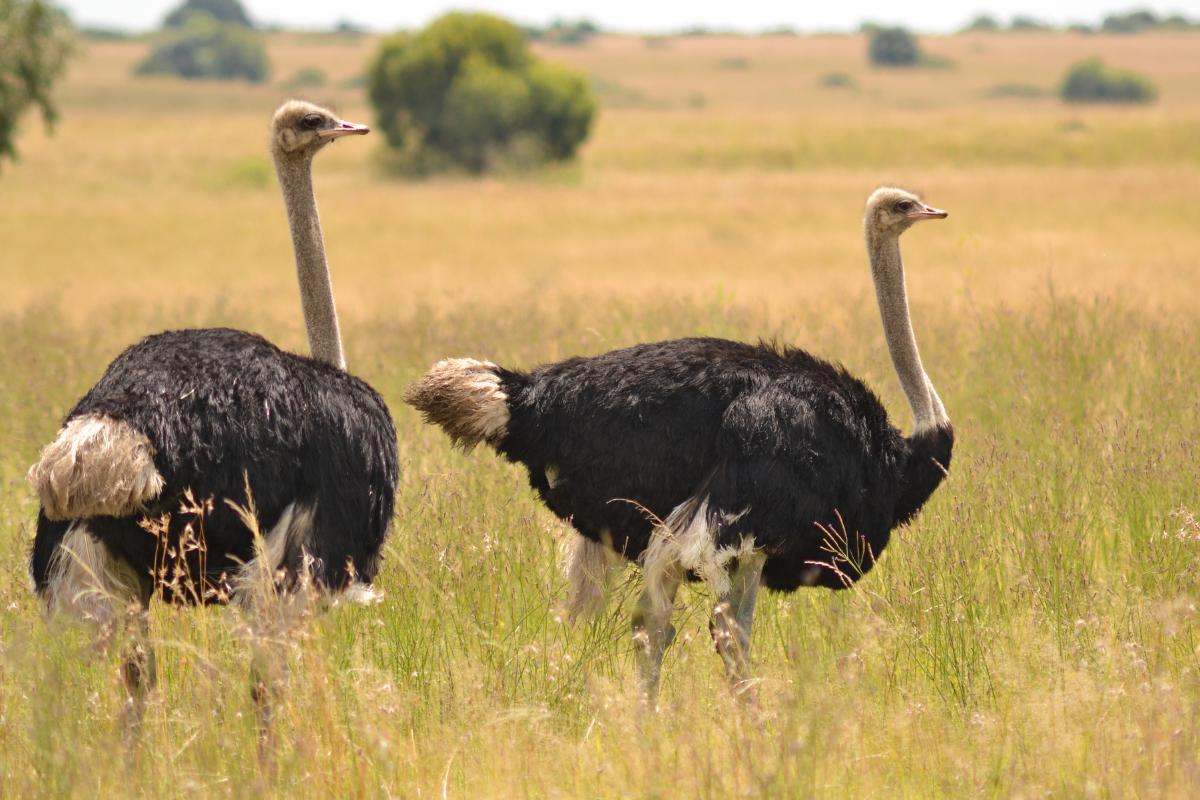Why Do Ostriches Have Wings?


Ostriches are known for their impressive size, speed, and unique adaptations that make them well-suited for life on land. One of these adaptations is their wings, which are relatively small compared to their massive bodies and are not used for flight. This raises the question: why do ostriches have wings if they cannot fly?
In this AnimalWised article, we will explore the various theories behind the evolution and purpose of ostrich wings, shedding light on these fascinating birds' adaptations and behavior.
What are ostriches?
Ostriches are a type of flightless bird that belongs to the family Struthionidae. They are the largest and heaviest living birds, with two recognized species: the common ostrich (Struthio camelus) and the Somali ostrich (Struthio molybdophanes).
Ostriches are native to Africa and can be found in savannas, grasslands, and desert regions.
They are well-known for their long necks, long legs with powerful thighs, and large eyes. Ostriches also have distinctive feathers, with males having black feathers and females having brownish-grey feathers.
Ostriches can weigh anywhere from 90 to 130 kilograms, which is roughly equivalent to 200 to 290 pounds. The weight can vary depending on factors such as age, sex, and habitat. However, even at their heaviest, ostriches are still unable to fly due to their unique anatomy.
They are omnivores, feeding on a variety of plants, seeds, insects, and small animals. Ostriches are farmed for their meat, skin, and feathers, and they have become a popular attraction in many zoos and animal parks around the world.
How big is an ostrich egg?
An ostrich egg is the largest egg of any living bird and can weigh up to 1.5 kilograms (3.3 pounds). It is approximately equivalent in volume to 24 chicken eggs. The shell of an ostrich egg is also very thick, up to 2-3 millimeters, making it a challenge to crack open.
Do ostriches bury their head in the sand?
No, ostriches do not actually bury their heads in the sand. This is a common misconception about ostriches. When an ostrich senses danger, it will often lay its head and neck flat on the ground, which may give the impression that it is burying its head in the sand. In reality, the ostrich is lowering its profile to make it less visible to potential predators.
Can ostriches fly?
No, ostriches cannot fly. They are part of a group of birds called ratites, which includes emus, kiwis, rheas, and cassowaries. Ratites lack the keel on their sternum, which is the bony structure that anchors the muscles used for flight in most birds. Therefore, they cannot generate enough lift to fly, but they have adapted to be fast runners instead.
Don't miss this other article where we examine the distinctions between a rhea and an ostrich.
Why don't ostriches fly?
Ostriches are a group of flightless birds that have adapted to their environment by losing their ability to fly. They are native to the savannas and deserts of Africa, where they have adapted to their surroundings by becoming efficient runners.
The evolution of flightlessness is believed to have occurred due to a decrease in predators that fed on them after the extinction of certain mammals and dinosaurs. This made flying less necessary for their survival, and over time they evolved to become better runners.
Ostriches are well-suited to running on land and have plenty of open space in their habitat to move around quickly. Running is a more energy-efficient way of escaping predators than flying, which requires a significant amount of energy. Therefore, ostriches have evolved to be better runners rather than fliers, which led to the loss of their ability to fly.
While the evolution of flightless birds is well-documented, ongoing research is still shedding light on this topic, and there is still much to learn about the evolution of ostriches and other flightless birds.
You might find this other article interesting, as we have compiled a list of 10 flightless birds, and provided detailed explanations on their characteristics and the reasons behind their inability to fly.

How do ostriches move?
As mentioned before, ostriches are well-adapted to terrestrial life, as they are unable to fly. Instead, they have evolved an efficient movement mechanism through walking and running. Their long and strong legs are highly effective for moving on land, and they can run at impressive speeds of up to 70 km/h, making them not only the largest birds but also the fastest in the world.
This speed, combined with their powerful legs and long strides, enables ostriches to easily outrun many of their natural predators such as lions, cheetahs, and hyenas. However, ostriches may still fall prey to certain predators such as wild dogs and leopards.
When confronted by a predator, ostriches will typically attempt to outrun the threat as their primary defense mechanism. However, if escape is not possible, they can also use their powerful legs to deliver a lethal kick with their sharp claws, which can cause serious injuries or even kill the attacker.
Ostriches have been heavily exploited for their meat, eggs, and feathers, which has led to their vulnerability and decreasing population. Currently, the common ostrich is listed as a species of "Least Concern" on the IUCN Red List of Threatened Species, which means that they are not currently at risk of extinction. The Somali ostrich, on the other hand, is classified as "Vulnerable" due to habitat loss and hunting.
Why do ostriches have wings?
Over time, as ostriches adapted to life on the ground, the need for wings for flight decreased, and wings became smaller and less functional. This led to a decrease in the size and function of their wings, as they were no longer necessary for survival.
These wings have evolved for other purposes, such as balance and stability while running, courtship displays, and for shade.
While running, the wings are held out to the sides and help to maintain balance and control during quick turns or sudden stops. During courtship displays, the males will flap their wings and spin around in an effort to attract a mate. Additionally, ostriches will use their wings to provide shade for themselves and others by holding them out from their bodies, much like an umbrella.
You may find this article interesting as well, as it discusses whether flamingos are capable of flight.
If you want to read similar articles to Why Do Ostriches Have Wings?, we recommend you visit our Facts about the animal kingdom category.
- Birdlife. (2023). Struthio . Available at: http://datazone.birdlife.org/species/results?thrlev1=&thrlev2=&kw=Struthio&fam=0&gen=0&spc=&cmn=®=0&cty=0
- Donegan, K. (2002). " Struthio camelus ". Animal Diversity Web. Available at: https://animaldiversity.org/accounts/Struthio_camelus/
- Jordan V. Smith, Edward L. Braun, Rebecca T. Kimball. (2013). Ratite Nonmonophyly: Independent Evidence from 40 Novel Loci. Systematic Biology , Volume 62, Issue 1, January. Pages 35–49, https://doi.org/10.1093/sysbio/sys067






